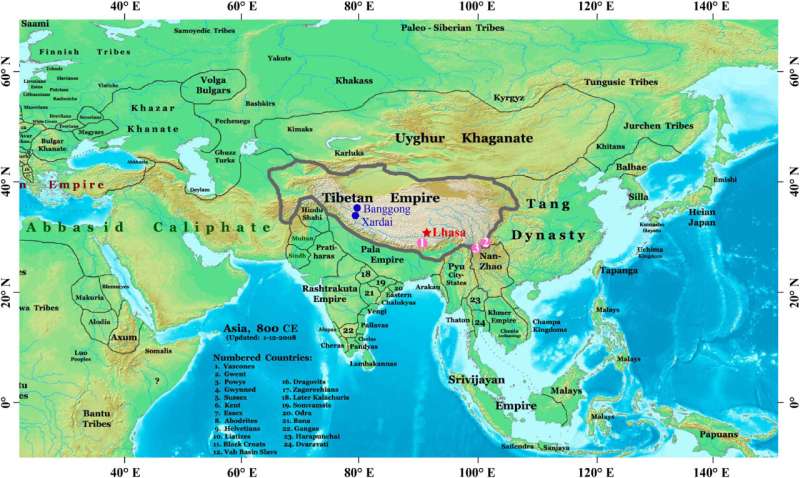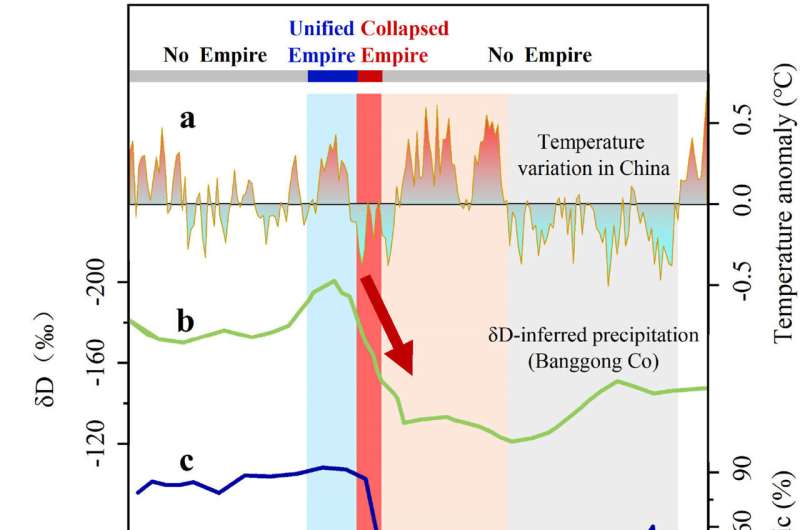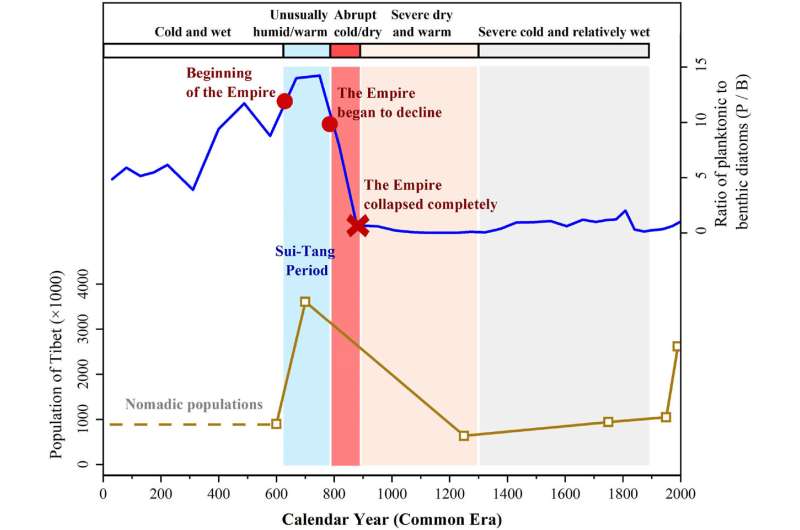September 6, 2023 feature
This article has been reviewed according to Science X's editorial process and policies. Editors have highlighted the following attributes while ensuring the content's credibility:
fact-checked
peer-reviewed publication
trusted source
proofread
Paleolimnological study attributes Tibetan Empire collapse in 9th century to climate change

The Tibetan Empire was the world's highest elevation empire, sitting over 4,000m above sea level, and thrived during 618 to 877 CE. Home to an estimated 10 million people, it spanned approximately 4.6 million km2 across East and Central Asia, extending into northern India.
Considering the hostile conditions for populations to expand, including hypoxia where oxygen concentrations are 40% lower than at sea level, it is incredible that the empire flourished. However, its collapse in the 9th century is not fully understood, with new research published in Quaternary Science Reviews aiming to untangle the role climate may have played in the end of a great civilization.
Zhitong Chen, from the Institute of Tibetan Plateau Research, China, and colleagues turned to the geological record of lake sediments (paleolimnology) to determine how the environment changed 12 centuries ago. Xardai Co's freshwater lake sediments preserve the remains of microscopic single-celled algae known as diatoms, with the research team noting a significant change from planktonic varieties (those drifting within a water body, generally nearer to the surface) to benthic forms (living near the lake floor). This is interpreted as representing a shift to drier conditions, therefore lowering lake levels.
There is a distinct pattern of high lake levels, suggesting warm and humid conditions prevailed during the rise and peak of the Tibetan Empire ca. 600-800 CE, before conditions intensified to severe drought, coinciding with the empire's collapse ca. 800-877 CE. Chen and collaborators link drought with the likelihood of crop failure leading to social unrest among the population, alongside religious and political challenges, thus consequently the empire's demise.
The Tibetan Plateau is extremely sensitive to changes in climate due to its elevation, with temperature and precipitation fluctuations varying significantly from the average experienced across Earth. The study lake, Xardai Co, is typically ice covered today from November to April, but experiences local temperature shifts between –12.1°C and 14.1°C, as well as 71mm annual rainfall. These factors have important consequences on lake levels and therefore the organisms that live within them.

Within the core drilled from the lake in 2020, 160 diatom taxa were identified, though only 23 were considered significantly abundant.
Preceding ca. 800 CE, the diatom assemblages were dominated by two planktonic forms, Lindavia radiosa and Lindavia ocellata, and smaller abundances of Amphora pediculus and Amphora inariensis. Here the ratio of planktonic to benthic forms peaked in the wet and humid conditions that caused elevated lake levels.
The tipping point at 800 CE however sees a rapid increase in benthic diatoms Amphora pediculus and Amphora inariensis, while the aforementioned open water Lindavia radiosa and Lindavia ocellata declined. This diatom community persisted until 1300 CE, when lake levels began to rise once again during the Little Ice Age.
The data were matched against other paleoenvironmental indicators from across the Tibetan Plateau and confirmed that these climate changes were persistent across the region, not solely localized to the study lake. This included precipitation records inferred from a second lake located 50km north of Xardai Co, Banggong Co, as well as temperature records from China.
Linking the climate changes to its impact upon the population of the time, agriculture and livestock farming were the dominant livelihoods, with crop production in the Yarlung Zangbo River valley and grazing on the Qangtang Plateau. During empire expansion, the warmth and rain would have encouraged crop production and wild pasture for grazing animals, as well as raised the altitude at which they could be grown. Horses, goats and yaks are grazing animals and were important for the trade economy of Tibet.

However, the comparatively sudden climate decline over ~60–70 years would have stunted plant growth, leading to a reduction in agriculture and pastoral grazing. This would have critical impacts on the survival of the population with food shortages as well as the economic prosperity of a trade-reliant empire. Social unrest likely followed, with fragmentation of different political agendas ultimately leading to the end of the Tibetan Empire.
Today, agriculture and pastoral activities account for over half of Tibet's annual income, so understanding climate's toll on communities in harsh environments is paramount to ensure they not only survive, but thrive.
More information: Zhitong Chen et al, Collapse of the Tibetan Empire attributed to climatic shifts: Paleolimnological evidence from the western Tibetan Plateau, Quaternary Science Reviews (2023). DOI: 10.1016/j.quascirev.2023.108280
Journal information: Quaternary Science Reviews
© 2023 Science X Network




















